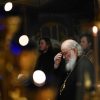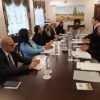In the name of the Father, and of the Son, and of the Holy Spirit. Amen.
Introduction
We hear a description of the incarnation of Christ in the popular Christmas hymn Hark, The Herald Angels Sing, which lends itself to our understanding of the significance of our feast today:
Veiled in flesh, the Godhead see,
Hail the incarnate deity!
Today, as we celebrate the Transfiguration of our Lord, the centrality of this event is that this “veil” which obscures our ability to see Christ as He is, was lifted and Christ was seen with the clearest of spiritual vision by three Disciples. Unlike how the Mother of God, Symeon the God-bearer, Anna the Prophetess, and John the Baptist saw Him, when Christ was seen as He walked in Galilee and Jerusalem, He looked to be a man like you and I. Only those who have had their hearts purified from passions, sins and their effects, are able to recognize Him and that only to the degree to which the Holy Spirit allows.[1]
What is distinct about the event of the Transfiguration of Christ is twofold and will be the subject of our homily today: first, it is a revelation about who Christ is, and, secondly, about how we are spiritually transformed.
It is quite popular to speak of “the doors of perception” and about those things which inhibit us from being able to see what is truly going on around us, and therefore many people attempt to overcome this blindness, this distorted vision, through drugs and by other means. Being aware of our motivations to do so, the founder of analytic psychology, C.G. Jung, once warned, “Beware of unearned wisdom.”
And yet, in Orthodoxy, and especially on this Feast today, we acknowledge that it is hard not to be deceived about our own selves, about others, and about the world around us. But in the narration of the events that surround our Lord being transfigured on Mt. Tabor, we are taught that although we may not know exhaustively, we can know true things about Christ and, by extension, about ourselves, and the world around us.
The Transfiguration of Christ
In the Gospel we heard a moment ago, let us back up a little to note what preceded this account. Jesus has just told His disciples, “Verily I say unto you, There be some standing here, which shall not taste of death, till they see the Son of man coming in his kingdom” (Matt. 16:28). Then the Gospel passage which we read begins by saying, “And after six days…”
-
The Kingdom
What is this kingdom about which Christ spoke? It is not a reference to the distant future as though the second coming was imminent or that some of the disciples were going to live for several hundred years. Nor is He speaking of a kingdom which moves from one place to another as it expands and contracts its territories. No, the “King of all” is everywhere present, as is His kingdom.[2] Christ is saying that the kingdom is the glory of the Father, in which Christ will be seen for who He is by those to whom He chooses to reveal it.
He who was in the beginning, who was with God and was God, by Whom all things were made, who also is the light and life of men, enlightening every man that cometh into the world (Cf. John 1). He dwells in unapproachable light (1 Tim. 6:16) but was made flesh and dwelt among us (John 1:14), writes the Apostle to whom Christ choose to reveal it.
And being made flesh, this flesh becomes a veil which covered Him from the sight of mankind unless they had the eyes to see past the veil.
Today, though, today, Peter, James, and John witness the transfiguration of Christ. What they see, through the power of the Holy Spirit, is the kingdom, Christ in the glory of the Father.
-
Beholding Christ
We read that His face did shine like the sun and His clothing was as white as snow, which is to say that Christ radiated with the glory that is natural to Him as God; the glory which will also accompany Him when He comes at the end of the age; the glory which is the light of the divinity of the Godhead. St. Gregory Palamas also calls this light “inexpressible, God’s divinity and kingdom, the beauty and resplendence of the divine nature, the vision and delight of the saints in the age without end, the natural ray and glory of the Divinity.”[3]
St. John of Damascus writes that Christ “was transfigured, then: not taking on what He was not, nor being changed to what He was not, but making what He was visible to his own disciples, opening their eyes and enabling them, who had been blind, to see.”[4],[5] That is, not only were the disciples able to see past the veil of Christ’s flesh but the veil was removed from their eyes. For that moment, they were able to see Christ truly, not with their bodily eyes but with the eye of their soul by the power of the Holy Spirit.
It is one thing to read a biography or a book about a foreign land, but it is quite another to meet the person or travel to that land, to see for oneself, to smell, to touch. And in this case, even more so. There is no sensory or intellectual hindrance to knowing what is before them for they see with unveiled faces (Cf. 2 Cor. 3:18).
-
Transformation
And how does this happen? By the work of the Holy Spirit who acts in either of two ways. The first is when we, with the grace of God, struggle to overcome the passions and cleanse our soul from this debris – for as smoke is to the eyes, so are passion and sins to our soul. Through the Fall, our nature was stripped of this divine illumination, and our foolish hearts were darkened, so Christ, having compassion towards our disfigurement took our nature upon Himself and clothed it in this brilliance. St. John Chrysostom writes that in the transfiguration, the disciples see that this is how we were in Adam before the Fall and this is what we shall become through Christ in the age to come.[6]
The second means by which the Holy Spirit acts is “all of a sudden,” as these three disciples were given the eyes to see the kingdom of Christ. St. Maximos the Confessor writes that they crossed over from the flesh to the spirit, at which time the veil of the passions which covers the nous was removed and then the mysteries of God were revealed to them.[7]
Conclusion
Though it is incredible to see how God has manifested Himself, as mentioned earlier, this was an exceptional circumstance and not the usual.
The Fathers note that the Transfiguration happened forty days before Christ’s crucifixion and for the purpose of strengthening these disciples for this event: “that when they would see Thee crucified,” as we chant in the Kontakion for the feast, “they would comprehend that Thy suffering was voluntary, and proclaim to the world that Thou art in truth the Effulgence of the Father.”[8]
Yet may we not abandon this event as being irrelevant to us who are only at the beginning of the spiritual life not seeing it’s significance for us. For this we can see in the following four points:
- That the love of God for us is evident throughout the account of the Transfiguration. God has come down from Heaven, from the lofty heights, to His creation that walks on the earth. And He, because of His love for mankind, condescended to come down to mankind and then elevates him and brings him up from the ground to the mountaintop where He reveals Himself to His beloved as far as His beloved can absorb. In this revelation, we see what we were created to be and although we fell away, we know that this is what we will become because of God’s love for us. But note that the disciples did not read about this in a book, they did not hear about it in a parable, but saw it face to face because Christ is the lover of mankind.[9]
- It is God who opens up the spiritual world to us. The revelation of the kingdom of Christ came all of a sudden to these disciples, being by the power of the Holy Spirit wherein He lifts the veil caused by the passions which cloud the eye of our soul from seeing the spiritual world. Even though this was done all at once for these disciples, for us it will happen but usually slower because as we live the Christian/ascetical life we slowly become purified of those passions. Even if we do not see Christ in this lifetime, there will be a day when our eyes will open into that other world wherein we will give an account of this life and receive the reward of our labors—Jesus Christ.
- Let us imitate the struggle of the saints. Although we may live in doubt regarding many things and perhaps believe that if only we were to have such experiences, we would feel more grounded in our beliefs and strengthened in our convictions, yet let us not look for experiences wherein we can be deceived, but instead imitate the struggle of those disciples, live as they lived, emulating our teachers and guides. Although we might not ascend to the heights like some of the saints whom we read about, yet they at least show us the path to God and where it goes. Being mindful of this, though we might not see the Uncreated Light, perhaps God will open our eyes to see our sins so that we would repent (and this is no small miracle).
- Lastly, learn humility. Like our Saviour, who was veiled in flesh, who humbled himself as a man though He was the Creator of man, and who was lead to the Cross voluntarily, but by His own creation, may we learn For as St. Isaac says, “There is no need for us to roam about heaven and earth inquest of God, or to send forth our minds into diverse places in search of Him. Purify your soul, O man, and drive away from you all cares which concern things outside your nature, and shroud you soul’s perception and movements with the veil of chastity and humility: by this means you will discover Him that is within you, since ‘mysteries are revealed to the humble’.”[10]
Through the prayers of our Holy Fathers, O Lord Jesus Christ our God, have mercy on us. Amen.
[1] “The power of God shone out visibly as if through thin glass to people who had the eyes of their hearts purified.” St. Gregory Palamas, “Homily 34 – On the Holy Transfiguration of Our Lord and God and Saviour Jesus Christ” in The Homilies of Saint Gregory Palamas, Christopher Veniamin, ed. (South Canaan: Saint Tikhon’s Seminary Press, 2004) 2:137.
[2] Cf. St. Gregory Palamas, Homily 34, 2:137.
[3] “Topics of Natural and Theological Science” G. E. H. Palmer, Philip Sherrard and Kallistos Ware trans. and ed. (Faber and Faber: London, 1995) 4:415.
[4] “Oration on the Transfiguration” in Light on the Mountain: Greek Patristic and Byzantine Homilies on the Transfiguration of the Lord, Brian J. Daley, S.J. trans. (Yonkers: St. Vladimir’s Seminary Press, 2013), 221.
[5] Philokalia, “The Declaration of the Holy Mountain”, G. E. H. Palmer, Philip Sherrard and Kallistos Ware trans. and ed. (Faber and Faber: London, 1995) 4:422; Cf. Topics of Natural and Theological Science, 4:414.
[6] Quoted by St. Gregory Palamas in Topics of Natural and Theological Science, 4:377. (Cf. Proclus, Patriarch of Constantinople, “Homily on the Transfiguration” in Light on the Mountain: Greek Patristic and Byzantine Homilies on the Transfiguration of the Lord, Brian J. Daley, S.J. trans. (Yonkers: St. Vladimir’s Seminary Pres, 2013), 93.
[7] “Ambigua to John” in On Difficulties in the Church Fathers: The Ambigua, Nicholas Constas, trans. and ed. (Cambridge: Dumbarton Oaks Medieval Library, 2014) 1:191.
[8] The Kontakion, tone VII, of the Feast of the Transfiguration.
[9] Cf. St. Gregory Nazianzen, Oration XLV / The Second Oration on Easter, XI.
[10] Ascetical Homilies. (Boston: Holy Transfiguration Monastery, 2011), 148-149.
















